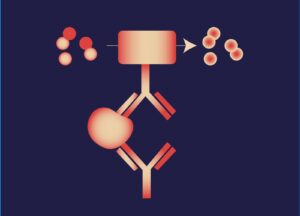



IBT specializes in delivering top-notch reagents tailored for research and development purposes.


Emerging viral threats often stem from viral mutations, which can enhance a virus’s ability to infect hosts, evade immune responses, or become more virulent. An unfortunate example of this is the COVID-19 pandemic, which has fundamentally changed how we live and function as a population. While detrimental, this event has also served as a stark reminder that continuous, infectious disease research is crucial for protecting human life.
The AG129 mouse, with its interferon (IFN) type I and II receptor-deficient immune system, is a valuable resource for evaluating the effectiveness of novel interventions against emerging viral infections that are not naturally susceptible in mice. It provides a cost-effective and robust first line of screening. AG129 mice, also known as interferon-alpha/beta (IFN-α/β) and interferon-gamma (IFN-γ) receptor double-knockout mice, are a transgenic strain of laboratory mice that have been genetically modified to lack functional receptors for both iIFN-α/β and IFN-γ. This double knockout mouse model is commonly used to study arboviruses, including DENV, ZIKA, CHIKV, and West Nile viruses. The AG129 mouse model can also screen non-enveloped RNA viruses, such as picornaviruses (e.g., enterovirus, coxsackievirus, etc.), that can cause significant brain damage and death. The AG129 mouse model also provides a platform for evaluating antiviral therapeutics against highly pathogenic EBOV and MARV viruses through pseudoviruses in a BSL-2 setting. This capability significantly reduces the economic and logistical burden of BSL-3 and BSL-4 testing and handling requirements. IBT has established lethal infections with non-mouse-adapted viruses using the AG129 mouse model to facilitate the advancement of critical therapeutics.
Key Applications of the AG129 Mouse Model in Infectious Disease Research:
1) Antibody Discovery Projects:
Monoclonal antibody or small molecule therapies are crucial for individuals who are unvaccinated or immunocompromised. The AG129 mouse efficacy model allows for rapid screening of many candidates in initial experiments, helping to identify lead candidates that can later be evaluated in costly BSL-3 and BSL-4 animal models.
2) Viral Load in Key Organs including Brain & Genital organs:
Many arboviruses, which are responsible for acute infections, can also reach the CNS and infect various cell types. In the AG129 model, we have demonstrated viral presence in the brain, reflecting human infection. Therefore, quantifying viral tissue load in the brain can serve as an early indicator of a drug’s potency during development. Similarly, many arboviruses have been isolated from or indirectly detected in the urogenital tract and sexual secretions of their vertebrate hosts including humans. Viral load quantification in various intricate organs such as infected animals’ brains, muscles, testes, and ovaries.
3) Neurotropism & Neurological Manifestations:
Researchers have also used AG129 mice to study viral dissemination of emerging neurotropic pathogens like picornaviruses (EV71) to investigate neurological forms of hand, foot, and mouth disease. Mouse brain-adapted strains have been used to successfully establish infection in neonates, causing neurological damage likely responsible for the observed limb paralysis in infected animals. Such models have been useful to investigated both vaccines & therapeutics.
Rapid research of emerging diseases and potential treatments is a complex journey. Animal models play a crucial role in exploring new therapies. Finding a BSL-2 model in a rapidly reproducing animal host can help advance much-needed therapies, making it possible to assess treatments quickly and cost-effectively. The AG129 mouse model helps to fulfill this need for the research community and provides a model that can be easily used in the advent of emerging viral pathogens.

Want more information or price estimates for AG129 Efficacy Studies? Share your information below and one of our representatives will be in touch soon.
Baldon, L. V. R., de Mendonça, S. F., Ferreira, F. V., Rezende, F. O., Amadou, S. C. G., Leite, T. H. J. F., Rocha, M. N., Marques, J. T., Moreira, L. A., & Ferreira, A. G. A. (2022, August 3). AG129 mice as a comprehensive model for the experimental assessment of mosquito vector competence for Arboviruses. Pathogens (Basel, Switzerland). https://www.ncbi.nlm.nih.gov/pmc/articles/PMC9412449/
Tanabe, I. S. B., Tanabe, E. L. L., Santos, E. C., Martins, W. V., Araújo, I. M. T. C., Cavalcante, M. C. A.,Lima, A. R. V., Câmara, N. O. S., Anderson, L., Yunusov, D., & Bassi, Ê. J. (2018, October 10). Cellular and molecular immune response to chikungunya virus infection. Frontiers in cellular and infection microbiology. https://www.ncbi.nlm.nih.gov/pmc/articles/PMC6191487/#:~:text=Humoral%20and%20cellular%20adaptive%20immune,B%20and%20T%20lymphocytes%2C%20respectively
Byaruhanga, T., Kayiwa, J. T., Nankya, A. M., Ataliba, I. J., McClure, C. P., Ball, J. K., & Lutwama, J. J. (2023, February 3). Arbovirus circulation, Epidemiology and Spatiotemporal Distribution in Uganda. IJID regions. https://www.ncbi.nlm.nih.gov/pmc/articles/PMC10006739/#:~:text=The%20global%20burden%20of%20arboviruses,and%20Latin%20America%20%5B2%5D.
Subscribe to the IBT Bioservices Tech Talk list and receive periodic updates on industry news and IBT Bioservices products and services.